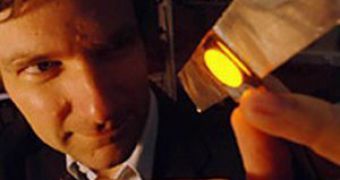A breakthrough device to cure skin cancer at patients' home has been recently developed by Scottish researchers. The device is actually a bandage accompanied by a source of light which must be attached to the sufferer's skin. Therefore, the bandage comes in the form of a sticking plaster which emits light. The light is emitted because the device is provided with a portable light source powered by a small battery.
The light source is actually the most important element of the portable 'sticking plaster' device, as the light activates the incorporated drug which treats skin cancer symptoms. The drug is photosensitive and when the light is turned on, it starts to become effective against skin cancer by destroying proliferating tumor cells.
One of the two scientists involved in the design and development of the anti-skin cancer patch, Professor Ifor Samuel of University of St. Andrews explained how the device works: "By adapting the latest technology to an existing treatment method, we have developed a compact light source for treating common skin cancers. It can be worn by the patient in a similar way to a sticking plaster while the battery is carried like an iPod."
The new-developed device is extremely useful for patients with the skin condition as it is small, easy to use and handle, very efficient in annihilating continuously dividing cancer cells and portable, allowing the patient to freely deal with his daily activities and tasks.
The other scientists who got involved in the 'creation' and development of the sticking plaster, Photobiologist Professor Ferguson of the Ninewells Hospital, Dundee, stated: "This new device will have a major impact on the treatment of skin cancers. The light emitting patch is a low cost, portable and convenient method of treatment. Using red light to treat skin cancer is a standard form of therapy but what we have done is take it out of the hospital setting into the home."
Prof. Ferguson also added that first trials proved to be successful, as the 'sticking plaster' reduced pain and eased symptoms in common skin cancer patients, allowing them at the same time to go on with their lives as if they were perfectly healthy. No more long hours spent in the clinics and hospitals to receive treatment for the condition and no need for extirpating the malignant tumor, this is what the revolutionary device offers to people with skin cancer. Moreover, they can fully benefit from the ability to move around freely and go on with their daily business, as the patch is not at all uncomfortable or inconvenient.
"Our initial pilot trials have already shown its effectiveness and we find patients requesting this treatment over conventional methods. You can have more than one plaster on at a time, covering multiple areas of affected skin. We have tried it on more than 20 patients so far and the results are comparable with standard hospital PDT treatment. We hope it could be widely available within about two years, freeing up nursing and doctor time - and hospital car parks," concluded Photobiologist Ferguson.

 14 DAY TRIAL //
14 DAY TRIAL //